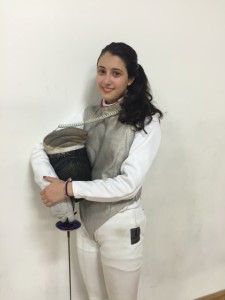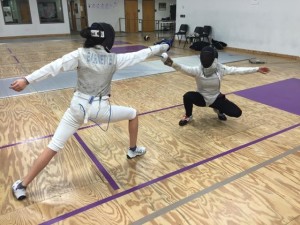Stone Ridge offers a wide variety of sports–but do they satisfy every student? Basketball, lacrosse, soccer, and swimming are ubiquitous at secondary schools, so they may seem unexciting. Our club teams, such as ice hockey and squash, are more unusual at the high school level, attracting more interest nationally and at the collegiate level. Our students are not afraid to leave their comfort zones and experiment with more atypical sports. Profiled below is Zoe Barnette, ’19, who participates in an uncommon high school sport–fencing.

Kathryn Maloney: Can you explain this sport to me?
Zoe Barnette: It’s really confusing. There are three main weapons–the foil, the épée, and the sabre. I do foil, which is what most people start with. The tip of the blade registers when you hit it [on an opponent]. To hit the torso of the opponent, there is a lamé [an electronically conductive jacket] that recognizes when it gets hit.
You have a wire connected to the blade that runs through you, and this is connected to a strip, which is connected to the box, which tells you who got the touch. The goal is to hit the other person with the blade five times or to have the most hits in three minutes. It’s kind of similar to tennis. The next round you have to get to 15 points. It’s based on right of way, so basically if you attack and they stick out an arm [to avoid being hit], it’s your point.
KM: How did you get into fencing?
ZB: My mom used to fence in college. In first grade I started fencing after school [and] really enjoyed it, and the instructor told me I was really good, so I decided to keep going.
KM: How much of your time does fencing take up?
ZB: I [fence] every Wednesday and Friday. My facility is in Columbia [Country Club], and the practice is three hours long. I have tournaments on the weekend, usually once a month, [and] sometimes nationally, sometimes locally.
KM: What is a typical fencing tournament like?
ZB: They’re seeded and it’s pool play with six to seven people in a pool. Then you get seeded again based on your results and move to [the] next round. Then you fence until you lose, and there’s no fourth place, it’s just tied for third.

KM: Are fencing facilities easily accessible?
ZB: There are some around here, but all of them focus on different weapons, which is why I have to go to Columbia [Country Club].
KM: Is fencing equipment expensive? What exactly is required?
ZB: It’s pretty expensive. I need knickers, which are like suspenders to protect the legs, made out of heavy-duty equipment, so the blade won’t go through. I also need a chest protector, jacket, lamé, glove, mask, cords, and weapons.
KM: Tell me about how you practice. Is it tiring?
ZB: It’s a lot of footwork and conditioning, which is pretty tiring. The actual fencing is not as tiring as the drills.
KM: What kind of career can a fencer have? Is there professional fencing?
ZB: They have it in the Olympics. You can’t really go very far except for that. There’s veteran fencing, but most of the money comes from advertising and sponsors.
KM: Does fencing hurt your body?
ZB: It hurts sometimes; I get bruises at most, sometimes cuts. It’s not as dangerous as perceived.
KM: Would you ever consider trying to start a fencing club at SR?
ZB: It’s more of a passion. I love watching others fence, and this area needs more fencing clubs. I think it would hard to get people into it, and more people would probably prefer regular sports.

Leave a Reply